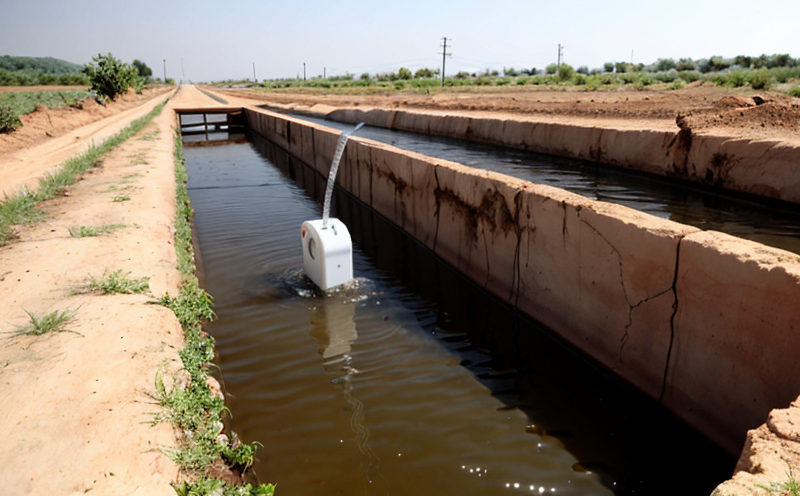ASTM D5810 Iron in Water Testing
The ASTM D5810 method is a standard practice for determining total iron concentration in water samples. This test is critical for industries that rely on high-quality water, particularly those in the mining sector where water quality directly impacts operations and environmental compliance.
Iron contamination in mine waters can lead to several issues: it can accelerate corrosion of infrastructure, reduce the efficiency of equipment, and pose health risks if not properly managed. Ensuring accurate iron concentrations is essential for maintaining operational integrity and preventing costly downtime or safety hazards. This method plays a crucial role in compliance with regulatory standards such as those set by the U.S. Environmental Protection Agency (EPA) and the World Health Organization (WHO).
The ASTM D5810 procedure involves several steps, including sample preparation, digestion of iron compounds, and colorimetric analysis using an iron(III) thiocyanate complex for detection. The method is known for its precision and accuracy, making it a reliable choice for laboratories entrusted with the responsibility of water quality assurance.
Compliance officers must ensure that all tests are conducted according to the latest standards to avoid non-compliance penalties. Quality managers rely on accurate iron concentrations in mine waters to maintain efficient operations and prevent costly disruptions. R&D engineers use this data to refine processes and improve product quality, while procurement teams need accurate test results to select suppliers who meet environmental and regulatory requirements.
The ASTM D5810 method is widely recognized for its robustness and reliability across various industries. Its stringent procedural guidelines ensure consistent results, making it a preferred choice among laboratories seeking precision in iron concentration measurement.
Scope and Methodology
The scope of the ASTM D5810 method is to provide a standardized procedure for determining total iron concentrations in water samples. This includes both dissolved and particulate forms of iron present in the sample matrix. The methodology involves several critical steps, each designed to ensure accurate and reliable results:
Sample Collection: Samples are collected from various points within the mine site, ensuring a representative mix of waters. Proper collection techniques are crucial to avoid introducing contaminants that could affect test accuracy.
Sample Digestion: The collected samples undergo digestion using nitric acid to release all forms of iron into solution. This step is essential for accurate quantification as it ensures complete dissolution of iron compounds in the water sample.
Colorimetric Analysis: After digestion, the sample is analyzed using a colorimetric method involving ferric thiocyanate and potassium ferrocyanide. The formation of a characteristic blue color indicates the presence of iron ions, which can then be quantified spectrophotometrically.
The ASTM D5810 method ensures that all tests are conducted under controlled conditions to minimize variability and ensure consistent results. This is achieved through rigorous procedural guidelines that have been validated for reliability and accuracy.
Customer Impact and Satisfaction
Implementing the ASTM D5810 iron in water testing method significantly impacts customer satisfaction by ensuring compliance with regulatory standards and maintaining operational integrity. Quality managers appreciate the precision of this test, as it allows for early detection of iron contamination issues that could otherwise lead to costly disruptions.
Compliance officers rely on accurate results from ASTM D5810 to avoid penalties associated with non-compliance. By adhering to these standards, mining companies can demonstrate their commitment to environmental responsibility and public health.
R&D engineers use the test data to refine processes and improve product quality. For example, understanding iron concentrations helps in optimizing water treatment methods to prevent corrosion and extend the lifespan of critical equipment.
Procurement teams benefit from accurate test results as they can select suppliers who meet environmental and regulatory requirements. This ensures that all materials used in mining operations are environmentally friendly and comply with international standards such as ISO 14001 and EN 16002.
Satisfied customers report higher operational efficiency, reduced downtime, and improved overall performance of their mining operations. The ASTM D5810 method plays a vital role in achieving these outcomes by providing reliable data that supports decision-making processes across the organization.
Environmental and Sustainability Contributions
The ASTM D5810 iron in water testing method contributes significantly to environmental sustainability efforts. By accurately measuring iron concentrations, this test helps mining companies identify areas where water treatment is needed, thereby reducing the environmental impact of iron runoff into nearby ecosystems.
This precision in measurement ensures that only necessary amounts of chemicals are used during water treatment processes, minimizing waste and chemical discharge into the environment. The method supports the broader goal of sustainable development by promoting efficient resource use and reduced pollution.
The data collected through ASTM D5810 testing also aids in the formulation of strategies to minimize iron contamination from mining activities. This includes implementing best practices for water management, such as recycling treated waters or using alternative sources that have lower iron content.
By adhering to this standard, mining companies can contribute positively to their communities and the environment, aligning with global sustainability goals set by organizations like the United Nations Environment Programme (UNEP).





